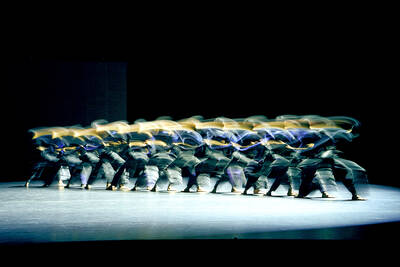No one knows the artist who scrawled white-paint outlines of sprawled bodies on the streets and sidewalks beneath Nusle Bridge.
The artist is a nobody -- just like most of the nearly 400 people who have died by leaping from the deck of the huge concrete span, Prague's strangely inglorious suicide bridge.
Unlike scenic suicide bridges in other cities, such as the Golden Gate in San Francisco or the Butte Chaumont in a Paris park, the Nusle Bridge is a skeleton-grey hulk that looms over a depressed neighbourhood of dirty sidewalks and crumbling flats.
Almost everyone who jumps from the bridge dies on pavement from the impact of a 40m fall, and is suddenly transformed into a grotesque spectacle for those who are living in the bridge's shadow.
"Sometimes when I go home from school, I see blood on the street," said Petr Paukert, 15, who lives with his family in a building under the bridge.
As he spoke Paukert glanced down at one of the painted body outlines. He flashed a nervous smile and added, "One time my neighbor took home a part of someone's brain in a cup."
Nusle's square concrete legs and wide deck were designed in communist times and tested for strength with Soviet tanks.
It opened in 1973 with six traffic lanes on the top deck. On the second level is an enclosed, two-track passageway for subway trains.
As long as anyone can remember, the bridge has been a favorite for the suicidal. It's easy to reach, and a fall is almost certain to kill. The anti-suicide fences installed some years ago will slow but seldom stop the jumpers.
Prague's unfenced river bridges, by contrast, do not attract people with a death wish because their decks are only half as high as Nusle's.
Almost every week, and more often in winter, police and firefighters respond to calls from motorists who see a distraught person preparing to jump off Nusle. Or they're called by someone below who found a body.
Hundreds have died, but hundreds have been saved as well.
On a Friday night this August, for example, firefighters used persuasion and guts to rescue a man with a young woman standing on the bridge's edge. They had apparently planned to leap together.
Among those who've witnessed many less fortunate victims is Victor Maticka, whose newspaper and tobacco shop is under the bridge's center.
He said every year at least 20 bodies fall on the street, sidewalk or onto parked cars near his shop. "The worst is around Christmas," he said.
Maticka talks about the experiences with a matter-of-fact grin, staring out his shop door toward the bridge. "It's just like Niagara Falls," he said.
Occasionally a Nusle suicide makes headlines. That was the case last year when the 21-year-old son of popular Czech singer Dalibor Janda jumped to his death.
Paukert remembers that suicide. "My father and I saw him lying on the ground," he said with a hint of pride.
"But this," the boy said, pointing to a body outline on the sidewalk, "is just art. It's nobody."

Most heroes are remembered for the battles they fought. Taiwan’s Black Bat Squadron is remembered for flying into Chinese airspace 838 times between 1953 and 1967, and for the 148 men whose sacrifice bought the intelligence that kept Taiwan secure. Two-thirds of the squadron died carrying out missions most people wouldn’t learn about for another 40 years. The squadron lost 15 aircraft and 148 crew members over those 14 years, making it the deadliest unit in Taiwan’s military history by casualty rate. They flew at night, often at low altitudes, straight into some of the most heavily defended airspace in Asia.

Beijing’s ironic, abusive tantrums aimed at Japan since Japanese Prime Minister Sanae Takaichi publicly stated that a Taiwan contingency would be an existential crisis for Japan, have revealed for all the world to see that the People’s Republic of China (PRC) lusts after Okinawa. We all owe Takaichi a debt of thanks for getting the PRC to make that public. The PRC and its netizens, taking their cue from the Chinese Communist Party (CCP), are presenting Okinawa by mirroring the claims about Taiwan. Official PRC propaganda organs began to wax lyrical about Okinawa’s “unsettled status” beginning last month. A Global

Taiwan’s democracy is at risk. Be very alarmed. This is not a drill. The current constitutional crisis progressed slowly, then suddenly. Political tensions, partisan hostility and emotions are all running high right when cool heads and calm negotiation are most needed. Oxford defines brinkmanship as: “The art or practice of pursuing a dangerous policy to the limits of safety before stopping, especially in politics.” It says the term comes from a quote from a 1956 Cold War interview with then-American Secretary of State John Foster Dulles, when he said: ‘The ability to get to the verge without getting into the war is

Like much in the world today, theater has experienced major disruptions over the six years since COVID-19. The pandemic, the war in Ukraine and social media have created a new normal of geopolitical and information uncertainty, and the performing arts are not immune to these effects. “Ten years ago people wanted to come to the theater to engage with important issues, but now the Internet allows them to engage with those issues powerfully and immediately,” said Faith Tan, programming director of the Esplanade in Singapore, speaking last week in Japan. “One reaction to unpredictability has been a renewed emphasis on